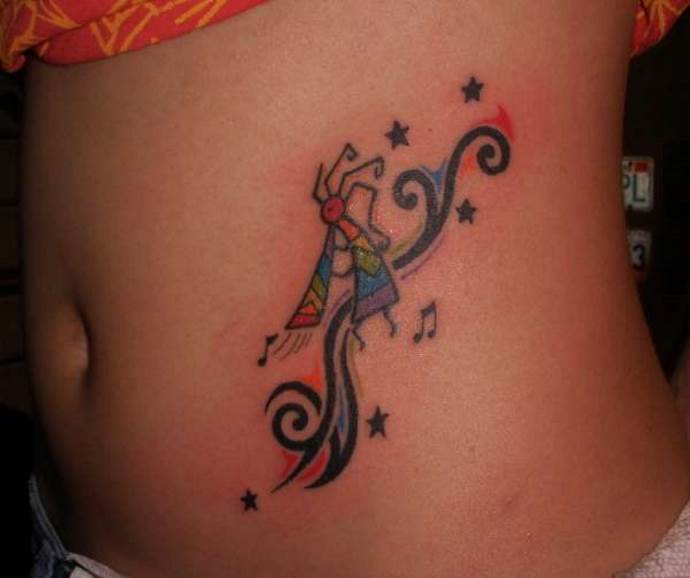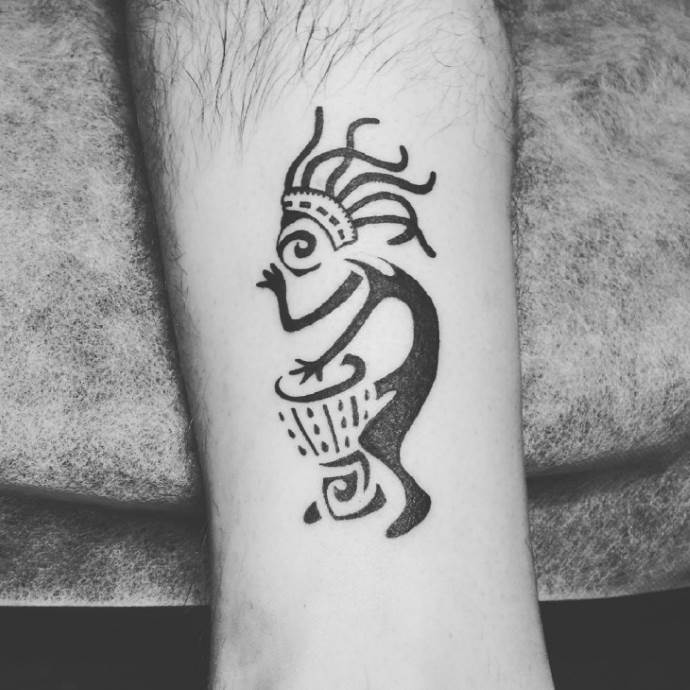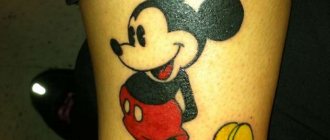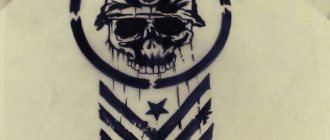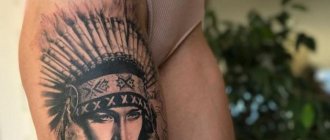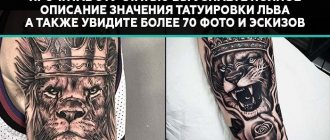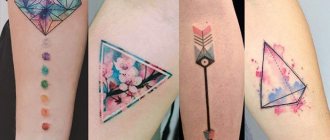Today we propose to find out the meaning of the tattoo with Kokopelli. That is how the deity of fertility is called. Often he is commonly depicted as a hunched over musician with a flute in his hands. Kokopelli is revered by many American tribes. Just like many other fertility deities, he is the patron saint of procreation and agriculture. He is a deity of law-breakers. And yet he does not regret it in the slightest, on the contrary, he is always happy about what he has done. It is believed that Kokopelli can influence human sexuality. In the myths, it is said that the deity often carries unborn children on his back. It is not uncommon for him to be involved in wedding rituals. By playing the flute, the deity can banish winter and entice spring. Many tribes identify him with rainy weather.
One theory of the Cocopelli's origin tells of the ancient Aztec traders who once lived there. They passed from Mexico to the southwest. These people carried all their goods in large sacks on their backs. When they approached settlements, they often used a flute to alert the locals.
The second version of origin suggests that the Kokopelli are anthropomorphic insects. Most early depictions show it as an insect-like creature.
Certainly Kokopelli is one of the most recognizable creatures to be found in southwestern petroglyphs.
What does the Kokopelli tattoo mean?
A beautiful Kokopelli nudge can sometimes be seen on both women's and men's bodies. Such an image would signify fun and mischief as well as sexual and creative energy. A person with such a tattoo is always having fun and enjoying life.
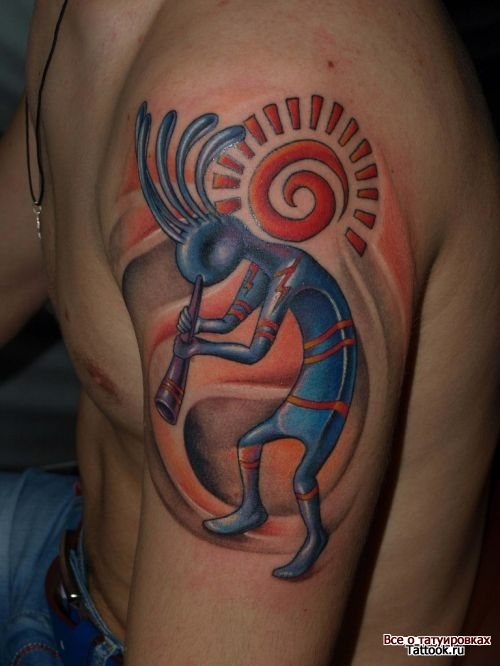
For him, the reproaches of others are not important at all. With his behavior, it seems as if he says that you need to be happy and enjoy every moment of life. Often such a tattoo is chosen by people of creative professions - musicians, artists, singers, writers. The owner of such a natal drawing does not want to make long plans for the future and be burdensome with memories of the past.
Variants, styles, combinations of Kokopelli tattoo
Do not think that on your body tattoos with Indian merry hunchback inflicted only lovers of Indian culture. The drawing can attract the attention of any person.
Usually Kokopelli stands alone in the image. The divine flutist is combined with pictures of notes, the sun, the moon, some animals from Indian folklore. He can also hold other musical instruments in his hands, not just the flute.
There is no specific style for Kokopelli, any variation is good. We can classify the tattoo as:
- Minimalism, where it is a black small design;
- Realism, which involves bright large sketches Kokopelli in color;
- Polynesian performance, here combines not combinable, but looks very original;
- Handpoke with a scruffy, sloppy character;
- graphics with precise fine lines, more often chosen by girls.
There is speculation that Aztec traders were the very first to use drawings with a humped man, where the hump represented a bag of goods. Long-term tattoos on the body were thought to be able to promote successful trade by attracting many customers.
Location for a Kokopelli tattoo
There are no rules on the choice of location for a tattoo, everyone is determined by himself. Girls prefer to apply the drawing on:
- ankle;
- scapula;
- wrist;
- forearm;
- thigh; etc.
Men, as a rule, beat the pattern on the back, shoulder or biceps. And in general, a positive and cheerful Kokopelli will be appropriate on almost any part of the body, the main thing is what it means.
Kokopelli tattoo is becoming more and more popular, it is performed in different variations and styles. The image of the little hunchbacked man with ruffled hair carries a positive, sincerity, joy, fun, prosperity.
Before you make any tattoo it is necessary to think carefully to choose a picture and a master. After all, the image stays with the person for life!
It is recommended to read: Horror Tattoo
The meaning for men
Often the tattoo with the image of the Indian god choose strong men. For them, such an image means:
- A cheerful disposition, optimism
- love of life
- mischief
- Sexuality
- belonging to creative professions
- Refusal to make long term plans and being burdened by memories of the past
A tattoo with a picture of Kokopelli will tell about the optimism and cheerful disposition of its owner.
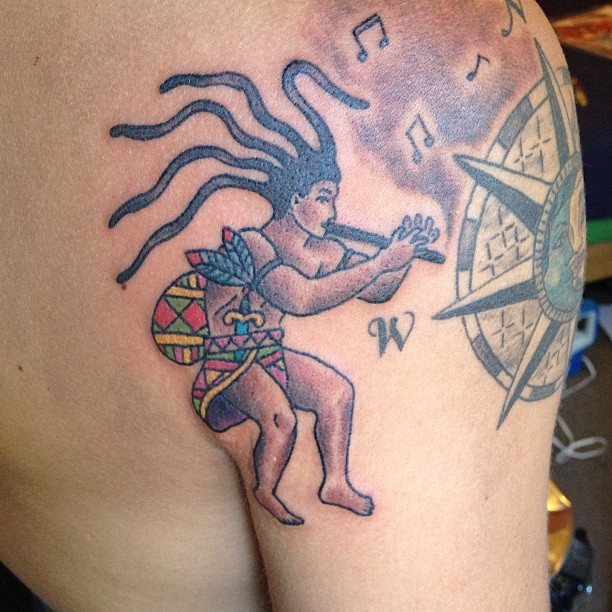

A man with such a body image does not want to make long term plans for the future and does not want to be burdened by memories of the past. The owner of such a body painting may belong to one of the creative professions.
Sometimes a man chooses a tattoo with Kokopelli because of the beauty of the image.
Kokopelli meaning
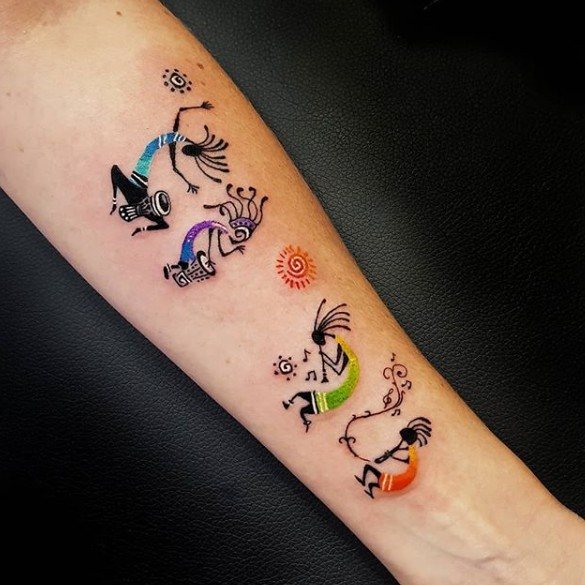

Kokopelli is a character from the legends of the indigenous peoples of North America. It is a very ancient symbol. The image is often found on clay jugs of tribes who lived in Southern Arizona about 3,000 years ago. It is believed that the Aztec traders invented the image of this man. He uses a flute to summon customers. And the hump is nothing more than a bag of goods.
There is also a theory that Kokopelli is a predatory insect. And his reproductive system is very developed.
There are disputes as to whether the little man is holding a flute or a shotgun. The Indians considered the hunchback to be the God of love, after whose visits women became pregnant the next day. Kokopelli would come to the village and use the sound of his flute to entertain the inhabitants. People would dance and sing the night away.
According to Native American myths, the hunchback brought seeds and songs in a bag. With his arrival came spring and heavy rains, which gave hope for a great harvest. Therefore, Native North Americans also considered him the god of fertility. And young people asked for family happiness and children, the fulfillment of cherished desires, as Kokopelli is also the patron of young families, the carrier of sexual energy and the grantor of wishes.
Kokopelli is a joker and mischievous man. For the sake of fun, he is capable of deceiving people. Therefore, the image can be seen on the body of a cheerful person who likes to joke wickedly. Such a person is an optimist, he knows how to enjoy life. He does not pay attention to the reproaches of others, as he seeks only positive moments in life.
Kokopelli's image can often be seen on the bodies of creative and creative people. This little man helps to think outside the box. His spirit patronizes actors, poets, artists, people with a rich imagination. Looks original tattoo of this deity in combination with notes, easels, a pen. The drawing will help to find success in creativity.
Tattoo with Kokopelli will suit people who love to travel and discover new places. The image of the deity carries only positive meaning. The tattoo will suit someone who wants not to lose optimism and believe only in good things. One look at the picture will help improve the mood and set a positive mood.
Kokopelli image will bring its owner a lot of fun, joy, sexual energy and even the birth of a child.
What does it mean for women?
It's not often you see a tattoo of the Indian god on a woman's body. But still sometimes and beautiful ladies choose realistic images with Kokopelli. For women, such a drawing would mean:
- naughtiness
- optimism
- love of life
- belonging to a creative profession
- sexuality
- abandonment of plans for the future
A woman with such a body painting is a real optimist. She loves to have fun and enjoys every day of her life.
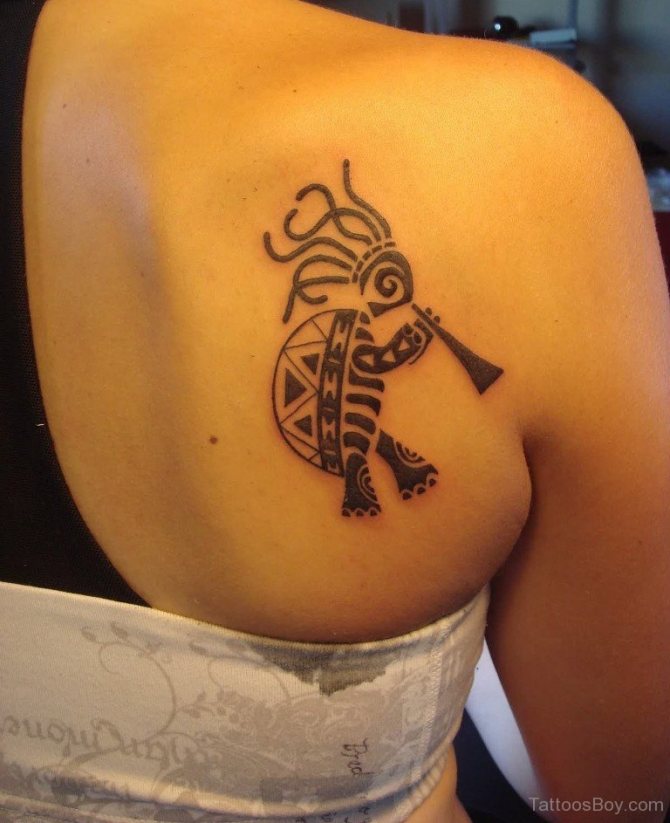

At the same time, she loves and naughty. Often such a tattoo choose representatives of creative professions. A woman with a body image of the Indian god does not want to make plans for the future and never regrets about the deed.
Often young girls and older women give preference to a body drawing with the Indian god because of the originality.
Styles of execution
Sketches for tattoos with Kokopelli are original and varied. If you want not just a piece of jewelry, but an amulet that will have symbolic meaning, take a closer look at the haida style. The image is usually done in red and black and looks organic on the shoulder blade, shoulder, leg or stomach.
The ethno technique is also an appropriate option in this case. Monochrome laconic tattoo with clear geometric figures and whimsical ornaments will pass the whole essence of the image (see photo below). Colorful image in the style of minimalism or old-school will always charge its owner positive and attract the attention of others.
You can add interesting additional elements to the composition. For example, Kokopelli, playing the flute on the prairie among the cacti, and the sunset as a background. Such a sketch for a tattoo looks good in color. A large-scale cartoon image is best applied on the back and on the chest in men.
Interesting video about digital tattoos
Tattoo pictures
What pattern to choose for a tattoo?
Tattoos depicting an Indian god are often very interesting and unusual. Each such image features a man with a musical instrument in his hands. In addition, there may be additional details in such a drawing. Tattoos with Kokopelli do black and white and colored.
Unusually looks tattoo in the style of Hyde. Such a body drawing is characterized by the presence of original patterns and red and white tones.
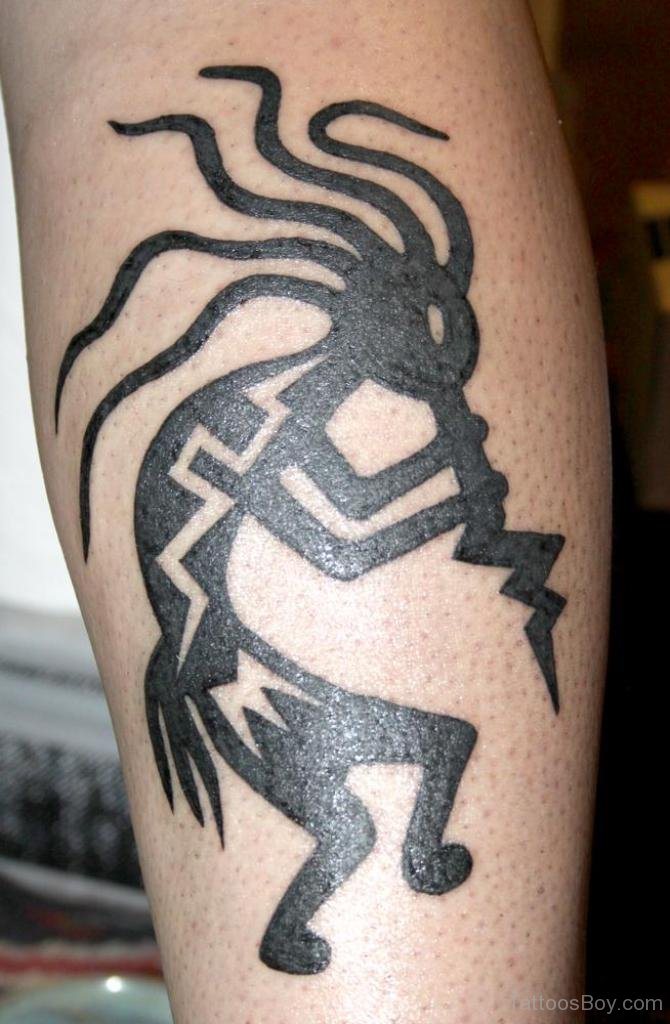

You can make an original tattoo on almost any part of the body. If you want the image to be larger, ask the master to apply it to the back or chest. If you wish to hide the body image, make a tattoo on your leg, arm, neck or shoulder.
Meaning of the tattoo for girls
Kokopelli tattoo is appropriate for both women and men. The cute little man will bring joy and optimism.
For women, the image has a special meaning. Often the deity is applied by women dreaming of a child. There is a belief that Kokopelli will hear a request and fulfill a girl's wish. At the same time the man must be depicted with a hump. The Indians believed that it was on the back of Kokopelli that the future mothers carried the children.
A deity pictured surrounded by seeds meant fertility and abundance, and brought good luck and the fulfillment of desires.
History
Kokopelli in Native Americans of North America is the god of fertility and prosperity. It is this deity who sends people a rich harvest. Also Kokopelli is the patron saint of procreation and young families. Therefore, it is mostly worshipped by young men and women, asking that the god fulfill their innermost dreams of happiness.
Interestingly, the god Kokopelli could appear in human form. He always had a flute with him, on which he played cheerful melodies. It was easy to tell that Kokopelli had come to the village: as soon as the deity descended, the season changed. Spring turned into summer, summer into fall, and winter into spring. As soon as Kokopelli appeared, people immediately started having fun, dancing, and enjoying life. The Indians danced to Kokopelli's flute all night long, and in the morning all the women found that they had conceived children.
Kokopelli was depicted as a hunchbacked man playing the flute. Another distinguishing feature of the god is his hair, which resembles antennae sticking out in all directions.
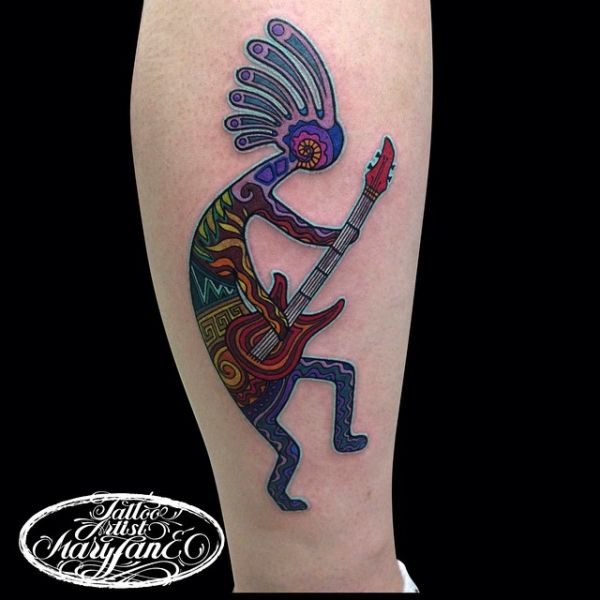

Tattoo of kokopelli with a guitar
This is interesting! Psychologists claim that Kokopelli is a typical trickster, that is, the embodiment of mischief, fun and sexual energy. Kokopelli can deceive a person, but he does it without malice, but only for fun. Therefore, often people who like to make fun of those around them decorate their bodies with an image of this Indian deity.
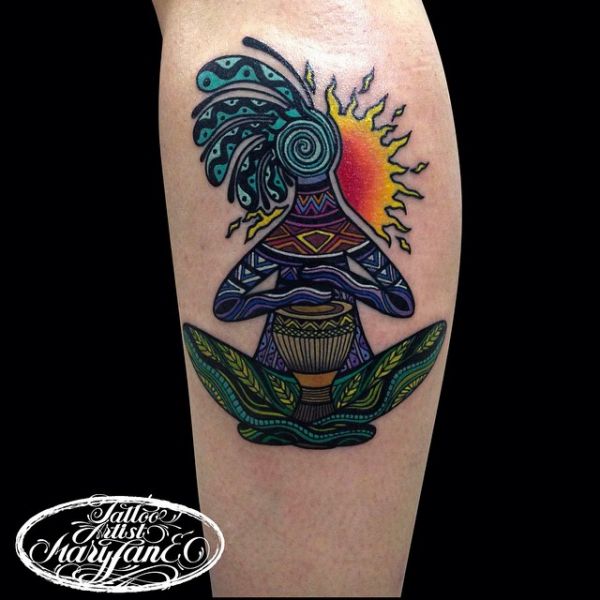

Kokopelli as a tattoo

